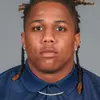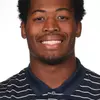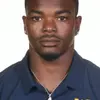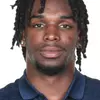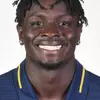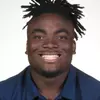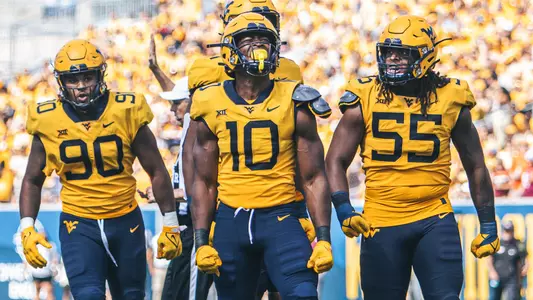
Photo by: WVU Athletic Communications
Hot Reads: Go for the Legs
September 24, 2021 07:00 PM | Football
Radio sideline reporter Jed Drenning provides periodic commentary on the Mountaineer football program for WVUsports.com. Be sure to follow him on Twitter @TheSignalCaller.
MORGANTOWN, W.Va. - It was New Year's Eve at Big Nose Kate's.
The history of the popular saloon in Tombstone, Arizona, is as rich as you'd expect. Originally opened as the Grand Hotel in 1880, the establishment in its earliest days housed some of the town's most legendary guests, including Doc Holliday, the Clanton Gang and even the Earp brothers themselves.
As you open the menu and find yourself deciding between the Showdown Salad and Curly Bill's Brisket Dinner, the barkeep might tell you the hotel registry included Ike Clanton and the two McLaury brothers the night before the latter pair met their fate at the iconic showdown just down Allen Street at the O.K. Corral in 1881. Because it did.
While in the Grand Canyon State for West Virginia's 2016 Cactus Bowl tilt against Arizona State, our family travelled a couple hours south of team headquarters in Scottsdale to soak in some history in Tombstone -- "the town too tough to die." Big Nose Kate's Saloon proved to be the perfect spot to settle in for an extended dinner between stops at the gunfight show and the Boothill Graveyard.
Adjacent to wagon wheels and whiskey bottles, Kate's had multiple TVs mounted inside. Under ordinary circumstances you might expect to see old reruns of something featuring Marshal Dillon or James Garner's Maverick. But that day all the sets were tuned into a College Football Playoff semifinal Orange Bowl battle between Oklahoma and Clemson.
Baker Mayfield and the Sooners looked the part, battling their way to a 17-16 halftime lead over Dabo Swinney's Tigers. By the time I'd taken my last bite of brisket, though, the game had careened in a decidedly different direction. The Clemson defense seized control, dictating the terms of the second half. The Tigers cruised to 21 unanswered points, shutting out OU for the final 30 minutes.
It was a rare thing to see – an Oklahoma offense laying a goose egg after the intermission. At the time, however, I didn't realize just how rare. It's happened only once in the 69 games since – a scoreless but inconsequential second half by OU in 2017 in which the Sooners played clock games against TCU in a 38-20 win.
Since that match-up I watched at Big Nose Kate's to close 2015, OU has maintained a clip of 45 points and 547 yards per contest – each tops in the nation. During this span, the Sooners have averaged 7.8 yards per play, also best in the country, while carving opponents up through the air to the tune of 300 yards or more passing 43 times and adding 17 games with 300-plus yards rushing, more than Ohio State (13), Clemson (11) and Alabama (8).
Along the way, the Oklahoma offense has claimed a Fred Biletnikoff Award (given to the country's premier wide receiver), a Joe Moore Award (given to the nation's most outstanding offensive line unit), two Heisman Trophies and one Heisman runner-up – with another candidate behind center this year rattling in the mix.
The impressive cherry on top of this crimson and cream sundae might be the Sooners' absurd streak of scoring 27-plus points in 65 straight games, a remarkable run that – oddly enough -- ended last Saturday when Oklahoma managed "just" 23 points in the win over old rival Nebraska. It was the longest such streak in college football since at least 1980. In case you're wondering, the second-longest was 31 games by UCF.
Is this noteworthy streak finally ending a good thing or a bad thing? Does it mean the Sooners have lost a bit of their mystique, or does it place the West Virginia defense in the crosshairs of an Oklahoma offense hell-bent against being contained two weeks in a row?
We all know Joe DiMaggio's fabled hitting streak ended at 56 games. Not as many folks realize that the day after it was snapped the Yankee Clipper was right back at it -- singling and doubling off Hall of Famer Bob Feller to spark a 16-game hitting streak.
Lincoln Riley's offense is exceptional. But exceptional, or even historically exceptional, doesn't mean perfect. So how might West Virginia hope to slay this high-scoring beast that prowls the prairie?
Go for the legs.
Even with a roster that -- hit by attrition -- is down to just two scholarship running backs, the Sooners ground game remains the lifeblood of the scheme Riley has perfected. So much of the creativity he brings to bear with the passing game stems from OU's ability to run the football effectively enough to keep defenses on their heels. The one-two punch of Kennedy Brooks (1,000-yard seasons at Oklahoma in 2018 and 2019) and Eric Gray (246 yards as a freshman in an SEC rivalry game in 2019 – sure it was Tennessee/Vanderbilt, but still) backed up by a couple talented walk-ons equip Riley with ample horsepower to strike a balance offensively.
Don't let these guys get cranking on the ground.
The quarterbacks and wide receivers – the Baker Mayfields, Kyler Murrays and Spencer Rattlers, the Dede Westbrooks, Marvin Mimses and CeeDee Lambs – are shiny objects that distract from the real engine that makes the OU offense go. That, of course, is an imposing combination of counter variations, old-school power, the stretch play, split zone and other run concepts that Riley deploys behind an always talented and well-coached offensive line and an array of versatile H-backs and tight ends. This shapes a formidable rushing attack, which sets the table for RPOs, bootlegs, play actions and a host of other constraint plays through the air that make life difficult to the extreme for defenses.
When the Sooners get their ground game humming, they're nearly unstoppable. In the 49 Big 12 games OU has won since Riley joined the staff, it has averaged 251 yards rushing per outing – right on pace with the 248 it has averaged in their its wins over the Mountaineers during that period. Conversely, in the six league losses Oklahoma has suffered during this time, that rushing number sinks to 138 per game.
Can West Virginia stymie – or at least decelerate -- that OU ground game? Maybe – but only by executing the things the Mountaineers have done when at their best. To continue in its pursuit of maintaining the standard of excellence established by last year's unit which led all Power Five schools in total defense, Jordan Lesley's crew needs to leverage the football, win one-on-ones, fight through double-teams, slam the door on pulling blockers and tackle like we know it can.
We've already seen at critical times that this can be an exceptional West Virginia defense with a strong sense of purpose. This group has been disruptive (topping the Big 12 in tackles-for-loss per game) and is at its best when pinned against the wall, ranking No. 1 in the nation in Red Zone Defense (in part by allowing just 27 yards in the last 29 plays it has faced inside its own 20). If West Virginia can bow its back and navigate success against the Sooners' run game, good things will follow against the pass.
As Neal Brown's defense tries to answer the bell, his offense will tangle with an aggressive Sooners unit that, for a second straight year, leads the Big 12 in sacks (4.3 per game) and takeaways (seven). Yards on the ground, necessary as they will be for West Virginia, will come at a premium. This is no longer the rudderless band of Oklahoma defenders that Tavon Austin gashed for 344 yards back in 2012.
This is the "Speed D" of Alex Grinch. This Grinch won't steal Christmas, but he will snuff out your ground game and make life hell for your quarterback.
Immediately upon arrival in 2019, Grinch reshaped the Sooners' defensive culture, punctuating it with an effective focus on stopping the run. It has worked. After leading the Big 12 in rush defense two years ago, OU kept it rolling last season with a league-best 94.7 rushing yards per game allowed in conference play. Oklahoma, this year, has picked up right where it left off – yielding just 2.6 yards per rush through three outings.
All of this presents a major challenge for a WVU offense that is still a work in progress. The good news? Unlike the struggling group that last visited Norman in 2019 on its way to finishing dead last in the Big 12 in scoring and total yards, these Mountaineers are built to throw at least a few punches of their own.
West Virginia leads the Big 12 in plays of 20-plus yards (18) and features the league's top scorer (Leddie Brown, tied for 1st with 12 points per game). WVU ranks No. 2 in the conference in Passing Offense (271 yards per game) and is one of just four FBS teams (Iowa State, Miami, North Carolina) with an active 8,000-yard career passer (Jarret Doege with 8,175) and an active 2,000-yard career rusher (Brown with 2,088). Moreover, the Mountaineers have showcased depth at receiver early in the year as the only team in the Big 12 with five different players who have registered 100-plus yards as pass-catchers (Sam James, Sean Ryan, Bryce Ford-Wheaton, Isaiah Esdale and Winston Wright Jr.).
The bad news? WVU's weaknesses play into OU's strengths. The Mountaineers are last in the Big 12 in turnovers lost with seven (six by the offense) and have struggled in pass protection, allowing 2.3 sacks per game – tied for worst in the league.
QUICK HITS …
 1) CAPTAIN CHAOS
1) CAPTAIN CHAOS
WVU bandit Jared Bartlett's game is predicated on speed. Neal Brown pointed out this week that against Virginia Tech, the Mountaineers shelved the twist games they'd been deploying with Bartlett and opened the barn door to unleash him as a straight edge rusher. He responded with Big 12 Defensive Player of the Week honors.
During one stretch in the second half that spanned 27 plays, Bartlett looked categorically unblockable. After a slow start to the 2021 season in which he managed just two tackles in the first two games, Bartlett transformed into an old gold and blue incendiary device against the Hokies – and his wick was lit late in the third quarter:
2) SECONDS, ANYONE?
Through three games, Oklahoma has owned the second quarter (outscoring opponents 51-0) and second down (43.4% of the Sooners touchdowns and first downs have come on second-down snaps).
This means two things.
First, after Oklahoma's initial salvo to start the game, you better settle in quickly because this crew doesn't start swinging its real haymakers until after feeling you out for two or three series. The scoring only tells part of the story of OU's second-quarter dominance. The Sooners have registered six of their 13 sacks in the second frame, while outgaining the opposition during those 15 minutes by a whopping margin of 6.8 yards per offensive play to 2.0.
As for Oklahoma's second-down success, the table is often set for that with a productive outcome the play before. If you consistently present Lincoln Riley with manageable second-down situations, he'll toy with you and take his shots. It's not a coincidence that Spencer Rattler leads all Big 12 quarterbacks with 328 passing yards on second down.
Winning on first down to knock an offense off schedule is always an important goal, but against OU it's an operational imperative. Big plays defensively are downstream of first-down success by your front seven. Case in point, both the interceptions Rattler threw in the opener against Tulane followed negative yardage plays on first down (a tackle-for-loss and a sack). If Dante Stills, Akheem Messidor and the Mountaineer defense can win more of those first-down battles than they lose Saturday night, they can go a long way toward marginalizing Oklahoma's second-down success.
3) A DOG'S LIFE
 In 1993, Don Nehlen's Mountaineers beat No. 4 Miami and No. 11 Boston College in back-to-back weeks. That marked the only time in school history West Virginia has won consecutive games against teams ranked in the top 15. Saturday night at Gaylord Family-Oklahoma Memorial Stadium, Neal Brown's squad will try to defy the odds and repeat that feat. With the Black Diamond Trophy tucked securely away back in Morgantown following a win over the No. 15 Hokies, the No. 4 Sooners now await.
In 1993, Don Nehlen's Mountaineers beat No. 4 Miami and No. 11 Boston College in back-to-back weeks. That marked the only time in school history West Virginia has won consecutive games against teams ranked in the top 15. Saturday night at Gaylord Family-Oklahoma Memorial Stadium, Neal Brown's squad will try to defy the odds and repeat that feat. With the Black Diamond Trophy tucked securely away back in Morgantown following a win over the No. 15 Hokies, the No. 4 Sooners now await.
Don't expect West Virginia to flinch – even as heavy underdogs. Not only have Brown's teams won four games as a double-digit dog since the start of 2017 (twice at WVU, twice at Troy), but as the offensive coordinator at Texas Tech a decade ago, he had a hand in a stunner for the ages. In 2011, Brown helped author a shocking upset in Norman. Executing Brown's offensive game plan to precision, (Jarret's older brother) Seth Doege threw 441 yards and four touchdowns as TTU snapped the Sooners' 39-game home winning streak.
The Sooners entered that game against Texas Tech 10 years ago as a gaudy four-touchdown favorite. It was a true David versus Goliath match-up. With West Virginia heading to Oklahoma as "merely" a 16.5-point underdog, the oddsmakers must see this one as more of a David and a couple Israelite archers versus Goliath.
Last year the Sooners were sloppy with the football in their first three games (six turnovers) as they broke in a new quarteraback. This season there have been growing pains as well while Oklahoma works to replace All-American Center Creed Humphrey, the anchor of OU's offensive line the past three years who is now snapping the ball in the NFL to Patrick Mahomes in Kansas City.
Humphrey was an exceptional talent and his absence (combined with a new starter at right tackle) has been felt. Rattler this season is averaging a pedestrian 7.7 yards per attempt. How far below the mark is that by OU standards? The lowest total by a Sooner starter in Riley's offense was 9.4 back in 2015.
Additionally, Rattler last year attempted 5.2 passes per game that were 20-plus yards downfield. This season, that figure has dropped to 2.0 per game. Those types of throws require pass protection that can hold up long enough to let deeper routes develop, and – without Humphrey -- the Oklahoma offensive line hasn't entirely turned that corner yet. But it will.
It's strange to say this about a team ranked No. 6 nationally in scoring (46 points per game), but the Sooners haven't played up to expectations. Like it did in 2020, however, OU will again get synced up and bust out. The question isn't if, but when. Here's hoping it isn't until next week at K-State.
Oklahoma is undeniably the most talented team in the Big 12 Conference.
To put OU against the ropes, WVU will have to win the line of scrimmage with the big fellas on both sides of the football. It's not as simple as it sounds, but that also happened to be the not-so-secret sauce of West Virginia's last victory over the Sooners – more than 13 years ago as champions of the 2008 Fiesta Bowl in Glendale, Arizona.
Just a couple hours up the road from Big Nose Kate's.
I'll see you at the 50.
MORGANTOWN, W.Va. - It was New Year's Eve at Big Nose Kate's.
The history of the popular saloon in Tombstone, Arizona, is as rich as you'd expect. Originally opened as the Grand Hotel in 1880, the establishment in its earliest days housed some of the town's most legendary guests, including Doc Holliday, the Clanton Gang and even the Earp brothers themselves.
As you open the menu and find yourself deciding between the Showdown Salad and Curly Bill's Brisket Dinner, the barkeep might tell you the hotel registry included Ike Clanton and the two McLaury brothers the night before the latter pair met their fate at the iconic showdown just down Allen Street at the O.K. Corral in 1881. Because it did.
While in the Grand Canyon State for West Virginia's 2016 Cactus Bowl tilt against Arizona State, our family travelled a couple hours south of team headquarters in Scottsdale to soak in some history in Tombstone -- "the town too tough to die." Big Nose Kate's Saloon proved to be the perfect spot to settle in for an extended dinner between stops at the gunfight show and the Boothill Graveyard.
Adjacent to wagon wheels and whiskey bottles, Kate's had multiple TVs mounted inside. Under ordinary circumstances you might expect to see old reruns of something featuring Marshal Dillon or James Garner's Maverick. But that day all the sets were tuned into a College Football Playoff semifinal Orange Bowl battle between Oklahoma and Clemson.
Baker Mayfield and the Sooners looked the part, battling their way to a 17-16 halftime lead over Dabo Swinney's Tigers. By the time I'd taken my last bite of brisket, though, the game had careened in a decidedly different direction. The Clemson defense seized control, dictating the terms of the second half. The Tigers cruised to 21 unanswered points, shutting out OU for the final 30 minutes.
It was a rare thing to see – an Oklahoma offense laying a goose egg after the intermission. At the time, however, I didn't realize just how rare. It's happened only once in the 69 games since – a scoreless but inconsequential second half by OU in 2017 in which the Sooners played clock games against TCU in a 38-20 win.
Since that match-up I watched at Big Nose Kate's to close 2015, OU has maintained a clip of 45 points and 547 yards per contest – each tops in the nation. During this span, the Sooners have averaged 7.8 yards per play, also best in the country, while carving opponents up through the air to the tune of 300 yards or more passing 43 times and adding 17 games with 300-plus yards rushing, more than Ohio State (13), Clemson (11) and Alabama (8).
Along the way, the Oklahoma offense has claimed a Fred Biletnikoff Award (given to the country's premier wide receiver), a Joe Moore Award (given to the nation's most outstanding offensive line unit), two Heisman Trophies and one Heisman runner-up – with another candidate behind center this year rattling in the mix.
The impressive cherry on top of this crimson and cream sundae might be the Sooners' absurd streak of scoring 27-plus points in 65 straight games, a remarkable run that – oddly enough -- ended last Saturday when Oklahoma managed "just" 23 points in the win over old rival Nebraska. It was the longest such streak in college football since at least 1980. In case you're wondering, the second-longest was 31 games by UCF.
Is this noteworthy streak finally ending a good thing or a bad thing? Does it mean the Sooners have lost a bit of their mystique, or does it place the West Virginia defense in the crosshairs of an Oklahoma offense hell-bent against being contained two weeks in a row?
We all know Joe DiMaggio's fabled hitting streak ended at 56 games. Not as many folks realize that the day after it was snapped the Yankee Clipper was right back at it -- singling and doubling off Hall of Famer Bob Feller to spark a 16-game hitting streak.
Lincoln Riley's offense is exceptional. But exceptional, or even historically exceptional, doesn't mean perfect. So how might West Virginia hope to slay this high-scoring beast that prowls the prairie?
Go for the legs.
Even with a roster that -- hit by attrition -- is down to just two scholarship running backs, the Sooners ground game remains the lifeblood of the scheme Riley has perfected. So much of the creativity he brings to bear with the passing game stems from OU's ability to run the football effectively enough to keep defenses on their heels. The one-two punch of Kennedy Brooks (1,000-yard seasons at Oklahoma in 2018 and 2019) and Eric Gray (246 yards as a freshman in an SEC rivalry game in 2019 – sure it was Tennessee/Vanderbilt, but still) backed up by a couple talented walk-ons equip Riley with ample horsepower to strike a balance offensively.
Don't let these guys get cranking on the ground.
The quarterbacks and wide receivers – the Baker Mayfields, Kyler Murrays and Spencer Rattlers, the Dede Westbrooks, Marvin Mimses and CeeDee Lambs – are shiny objects that distract from the real engine that makes the OU offense go. That, of course, is an imposing combination of counter variations, old-school power, the stretch play, split zone and other run concepts that Riley deploys behind an always talented and well-coached offensive line and an array of versatile H-backs and tight ends. This shapes a formidable rushing attack, which sets the table for RPOs, bootlegs, play actions and a host of other constraint plays through the air that make life difficult to the extreme for defenses.
When the Sooners get their ground game humming, they're nearly unstoppable. In the 49 Big 12 games OU has won since Riley joined the staff, it has averaged 251 yards rushing per outing – right on pace with the 248 it has averaged in their its wins over the Mountaineers during that period. Conversely, in the six league losses Oklahoma has suffered during this time, that rushing number sinks to 138 per game.
Can West Virginia stymie – or at least decelerate -- that OU ground game? Maybe – but only by executing the things the Mountaineers have done when at their best. To continue in its pursuit of maintaining the standard of excellence established by last year's unit which led all Power Five schools in total defense, Jordan Lesley's crew needs to leverage the football, win one-on-ones, fight through double-teams, slam the door on pulling blockers and tackle like we know it can.
We've already seen at critical times that this can be an exceptional West Virginia defense with a strong sense of purpose. This group has been disruptive (topping the Big 12 in tackles-for-loss per game) and is at its best when pinned against the wall, ranking No. 1 in the nation in Red Zone Defense (in part by allowing just 27 yards in the last 29 plays it has faced inside its own 20). If West Virginia can bow its back and navigate success against the Sooners' run game, good things will follow against the pass.
As Neal Brown's defense tries to answer the bell, his offense will tangle with an aggressive Sooners unit that, for a second straight year, leads the Big 12 in sacks (4.3 per game) and takeaways (seven). Yards on the ground, necessary as they will be for West Virginia, will come at a premium. This is no longer the rudderless band of Oklahoma defenders that Tavon Austin gashed for 344 yards back in 2012.
This is the "Speed D" of Alex Grinch. This Grinch won't steal Christmas, but he will snuff out your ground game and make life hell for your quarterback.
Immediately upon arrival in 2019, Grinch reshaped the Sooners' defensive culture, punctuating it with an effective focus on stopping the run. It has worked. After leading the Big 12 in rush defense two years ago, OU kept it rolling last season with a league-best 94.7 rushing yards per game allowed in conference play. Oklahoma, this year, has picked up right where it left off – yielding just 2.6 yards per rush through three outings.
All of this presents a major challenge for a WVU offense that is still a work in progress. The good news? Unlike the struggling group that last visited Norman in 2019 on its way to finishing dead last in the Big 12 in scoring and total yards, these Mountaineers are built to throw at least a few punches of their own.
West Virginia leads the Big 12 in plays of 20-plus yards (18) and features the league's top scorer (Leddie Brown, tied for 1st with 12 points per game). WVU ranks No. 2 in the conference in Passing Offense (271 yards per game) and is one of just four FBS teams (Iowa State, Miami, North Carolina) with an active 8,000-yard career passer (Jarret Doege with 8,175) and an active 2,000-yard career rusher (Brown with 2,088). Moreover, the Mountaineers have showcased depth at receiver early in the year as the only team in the Big 12 with five different players who have registered 100-plus yards as pass-catchers (Sam James, Sean Ryan, Bryce Ford-Wheaton, Isaiah Esdale and Winston Wright Jr.).
The bad news? WVU's weaknesses play into OU's strengths. The Mountaineers are last in the Big 12 in turnovers lost with seven (six by the offense) and have struggled in pass protection, allowing 2.3 sacks per game – tied for worst in the league.
QUICK HITS …
 1) CAPTAIN CHAOS
1) CAPTAIN CHAOSWVU bandit Jared Bartlett's game is predicated on speed. Neal Brown pointed out this week that against Virginia Tech, the Mountaineers shelved the twist games they'd been deploying with Bartlett and opened the barn door to unleash him as a straight edge rusher. He responded with Big 12 Defensive Player of the Week honors.
During one stretch in the second half that spanned 27 plays, Bartlett looked categorically unblockable. After a slow start to the 2021 season in which he managed just two tackles in the first two games, Bartlett transformed into an old gold and blue incendiary device against the Hokies – and his wick was lit late in the third quarter:
- 4:02 mark in the third quarter: Bartlett used that above mentioned speed to run the hump and battle through an egregious hold by Virginia Tech left tackle Luke Tenuta, getting home on a blindside sack of quarterback Braxton Burmeister.
- 10:00 mark in the fourth quarter: Bartlett overmatched running back Jalen Holston with a bull rush for another sack of Burmeister.
- 6:20 mark in the fourth quarter: Bartlett again used a speed rush to beat right tackle Brock Huffman for another sack, this time stripping the ball before Burmeister could release it.
- 4:36 mark in the fourth quarter: Bartlett forced a hurried, errant throw by Burmeister who was targeting running back Raheem Blackshear on a wheel route. Tech had a shot at a big play as Blackshear had a step on a WVU defender, but the pressure by Bartlett erased that possibility.
- 4:02 mark in the fourth quarter: Bartlett burst off the edge to beat the tackle Hoffman, this time fighting through a shoulder grab that was firm enough to twist his body, forcing him to slam his back into the Hokies quarterback. Burmeister ducked and brought both arms in – as much for personal protection as for ball security. The signal caller recoiled as if bracing for a bear attack before stumbling into the grasp of Taijh Alston and Jordan Jefferson for a sack with a bow on it.
2) SECONDS, ANYONE?
Through three games, Oklahoma has owned the second quarter (outscoring opponents 51-0) and second down (43.4% of the Sooners touchdowns and first downs have come on second-down snaps).
This means two things.
First, after Oklahoma's initial salvo to start the game, you better settle in quickly because this crew doesn't start swinging its real haymakers until after feeling you out for two or three series. The scoring only tells part of the story of OU's second-quarter dominance. The Sooners have registered six of their 13 sacks in the second frame, while outgaining the opposition during those 15 minutes by a whopping margin of 6.8 yards per offensive play to 2.0.
As for Oklahoma's second-down success, the table is often set for that with a productive outcome the play before. If you consistently present Lincoln Riley with manageable second-down situations, he'll toy with you and take his shots. It's not a coincidence that Spencer Rattler leads all Big 12 quarterbacks with 328 passing yards on second down.
Winning on first down to knock an offense off schedule is always an important goal, but against OU it's an operational imperative. Big plays defensively are downstream of first-down success by your front seven. Case in point, both the interceptions Rattler threw in the opener against Tulane followed negative yardage plays on first down (a tackle-for-loss and a sack). If Dante Stills, Akheem Messidor and the Mountaineer defense can win more of those first-down battles than they lose Saturday night, they can go a long way toward marginalizing Oklahoma's second-down success.
3) A DOG'S LIFE
 In 1993, Don Nehlen's Mountaineers beat No. 4 Miami and No. 11 Boston College in back-to-back weeks. That marked the only time in school history West Virginia has won consecutive games against teams ranked in the top 15. Saturday night at Gaylord Family-Oklahoma Memorial Stadium, Neal Brown's squad will try to defy the odds and repeat that feat. With the Black Diamond Trophy tucked securely away back in Morgantown following a win over the No. 15 Hokies, the No. 4 Sooners now await.
In 1993, Don Nehlen's Mountaineers beat No. 4 Miami and No. 11 Boston College in back-to-back weeks. That marked the only time in school history West Virginia has won consecutive games against teams ranked in the top 15. Saturday night at Gaylord Family-Oklahoma Memorial Stadium, Neal Brown's squad will try to defy the odds and repeat that feat. With the Black Diamond Trophy tucked securely away back in Morgantown following a win over the No. 15 Hokies, the No. 4 Sooners now await. Don't expect West Virginia to flinch – even as heavy underdogs. Not only have Brown's teams won four games as a double-digit dog since the start of 2017 (twice at WVU, twice at Troy), but as the offensive coordinator at Texas Tech a decade ago, he had a hand in a stunner for the ages. In 2011, Brown helped author a shocking upset in Norman. Executing Brown's offensive game plan to precision, (Jarret's older brother) Seth Doege threw 441 yards and four touchdowns as TTU snapped the Sooners' 39-game home winning streak.
The Sooners entered that game against Texas Tech 10 years ago as a gaudy four-touchdown favorite. It was a true David versus Goliath match-up. With West Virginia heading to Oklahoma as "merely" a 16.5-point underdog, the oddsmakers must see this one as more of a David and a couple Israelite archers versus Goliath.
***
Last year the Sooners were sloppy with the football in their first three games (six turnovers) as they broke in a new quarteraback. This season there have been growing pains as well while Oklahoma works to replace All-American Center Creed Humphrey, the anchor of OU's offensive line the past three years who is now snapping the ball in the NFL to Patrick Mahomes in Kansas City.
Humphrey was an exceptional talent and his absence (combined with a new starter at right tackle) has been felt. Rattler this season is averaging a pedestrian 7.7 yards per attempt. How far below the mark is that by OU standards? The lowest total by a Sooner starter in Riley's offense was 9.4 back in 2015.
Additionally, Rattler last year attempted 5.2 passes per game that were 20-plus yards downfield. This season, that figure has dropped to 2.0 per game. Those types of throws require pass protection that can hold up long enough to let deeper routes develop, and – without Humphrey -- the Oklahoma offensive line hasn't entirely turned that corner yet. But it will.
It's strange to say this about a team ranked No. 6 nationally in scoring (46 points per game), but the Sooners haven't played up to expectations. Like it did in 2020, however, OU will again get synced up and bust out. The question isn't if, but when. Here's hoping it isn't until next week at K-State.
Oklahoma is undeniably the most talented team in the Big 12 Conference.
To put OU against the ropes, WVU will have to win the line of scrimmage with the big fellas on both sides of the football. It's not as simple as it sounds, but that also happened to be the not-so-secret sauce of West Virginia's last victory over the Sooners – more than 13 years ago as champions of the 2008 Fiesta Bowl in Glendale, Arizona.
Just a couple hours up the road from Big Nose Kate's.
I'll see you at the 50.
Players Mentioned
Coal Rush Miners' Tribute 2025
Friday, October 24
Coal Rush Miners' Tribute
Friday, October 24
TCU Game (Coal Rush) Uniform Reveal
Friday, October 24
United Bank Playbook: TCU Preview
Wednesday, October 22
